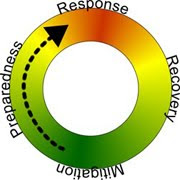 Sometimes I read something and it makes my head hurt. (Not really, I only wrote that for effect.) Eric Brown nearly did that with his post on un-integrating marketing.
Sometimes I read something and it makes my head hurt. (Not really, I only wrote that for effect.) Eric Brown nearly did that with his post on un-integrating marketing. "As of late I have found myself trying to be closer to the center, saying such things as you need an integrated marketing approach," he wrote on Social Media Explorer. "I think that is a mistake."
And then he goes on to suggest that we ought to all be asking: “What marketing venue or platform are you going to stop doing, before you start doing social media marketing?" And there's the problem. Integrated communication or integrated marketing has absolutely nothing to do with how many things a marketing department (and other departments) does.
It has more to do with developing a fluid plan on how to best achieve the strategic intent of the organization, usually with a set of priorities and then making sure the messages fit within some sort of context. Does anyone appreciate the difference?
The Un-Integrated Approach To Marketing And Public Relations.
I've sat in countless marketing meetings. The traditional approach — non-integrated — is simple enough. Everyone gathers around the table and reports on what they are doing.
"We're running a contest to get more Facebook friends," says the social media expert.
"We've successfully placed a story on how our CEO likes horses," says the public relations representative.
"We put together our projections for the next quarter to boost share prices," says investor relations.
"We're asking employees to donate canned goods for the local shelter," says community relations.
"We just finished the latest creative campaign and are making media buys. It's cool, wait until you see the fish," says the ad guy.
"We just mailed out 100,000 letters with coupons and anticipate a 1.2 percent return," exclaims the direct response ninja.
"Okay, I get direct response. But what does any of the rest of it have to do with sales?" grumbles the marketing guy. "We need a bigger sales force and a big tent sale."
And the list goes on, without anybody considering what is really happening. Multiple departments, in house or not, are running multiple objectives, almost none of which line up with what the organization does or differentiates itself in the market.
Social media is gathering fans. Public relations is placing stories. Investor relations is keeping people happy. Community relations makes people feel good. The creative department is driving awareness. Direct response is playing the odds. And marketing is trying to increase conversation rates (or whatever). That's a lot of objectives. Too many. And all of them have to do with disciplines, not what the company actually does.
The Integrated Approach To Communication Is Different.
Instead of playing round robin, various departments come together to discuss their top ideas on how to best communicate the objectives of the organization. It could be a product launch or perhaps something more generalized like becoming the subject matter expert in the space (hint: possibly because that's part of the company's mission).
Whatever. Let's say it's a product launch (to keep things simple).
The advertising department creates a campaign to launch the product, one that reinforces the unique selling proposition developed by marketing out of customer focus groups and other research. Social media says they will share the campaign (and any media mentions) across various networks and offer a product sample to select fans and friends.
 Public relations sends the product out to various reviewers, but also sees an opportunity to partner with related organizations as stakeholders. Community relations supports the idea, suggesting 1 percent of sales could even benefit a nonprofit with which the organization is strategically aligned.
Public relations sends the product out to various reviewers, but also sees an opportunity to partner with related organizations as stakeholders. Community relations supports the idea, suggesting 1 percent of sales could even benefit a nonprofit with which the organization is strategically aligned. Direct response, rather than sending coupons, suggests that they vet their database after the initial campaign launch, targeting customers who would be interested but don't take action on the campaign. Marketing suggests that all these ideas are solid enough; the marketing department will brief all the salespeople so they can answer any questions online and off.
Investor relations agrees that it all sounds great, and is already working on a separate announcement that ties the campaign to beating analyst projections in the next quarter. That makes everyone happy, especially because they all have shares in the company.
You don't even have to ask what this approach might do for sales. Assuming the product isn't a flop, it would drive sales.
That's integrated communication. That's integrated marketing. And if the communication teams are doing anything but that, then they are wasting the marketing budget.
If more organizations did this, then fewer would ever have to consider the Stop Doing List that excited Brown. You don't need a "stop doing list" because the most expedient way to prevent useless tasks from getting on the to do list is to always make sure they line up with the strategic goals of the organization in the first place. That requires integration.
Even more importantly, integrated communication (or integrated marketing if you prefer) keeps everyone moving in the same direction with specific (but flexible) messages. Given that people are already exposed to enough messages every day to fill one or two novels, the chance they will remember more than one or two messages about your organization is miniscule. And for many organizations, if they even remember one it is an accomplishment.
None of this is designed to take away from Brown's considerable insights; it's only meant to elevate the discussion. And perhaps that discussion needs to be that there is only one consistency in communication. Most people define terms so differently that they don't always mean what they are saying in social media even when they think they do.


























